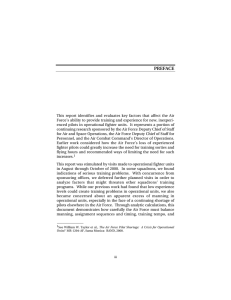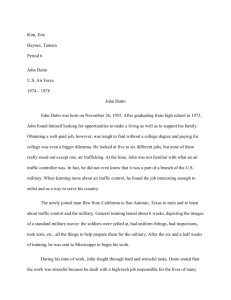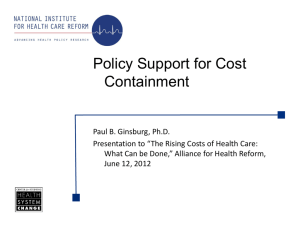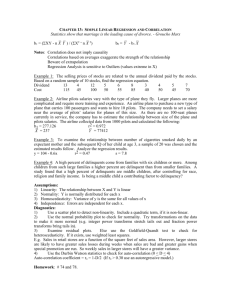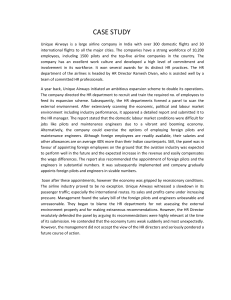EMPIRICAL EVIDENCE FROM OPERATIONAL UNITS
advertisement
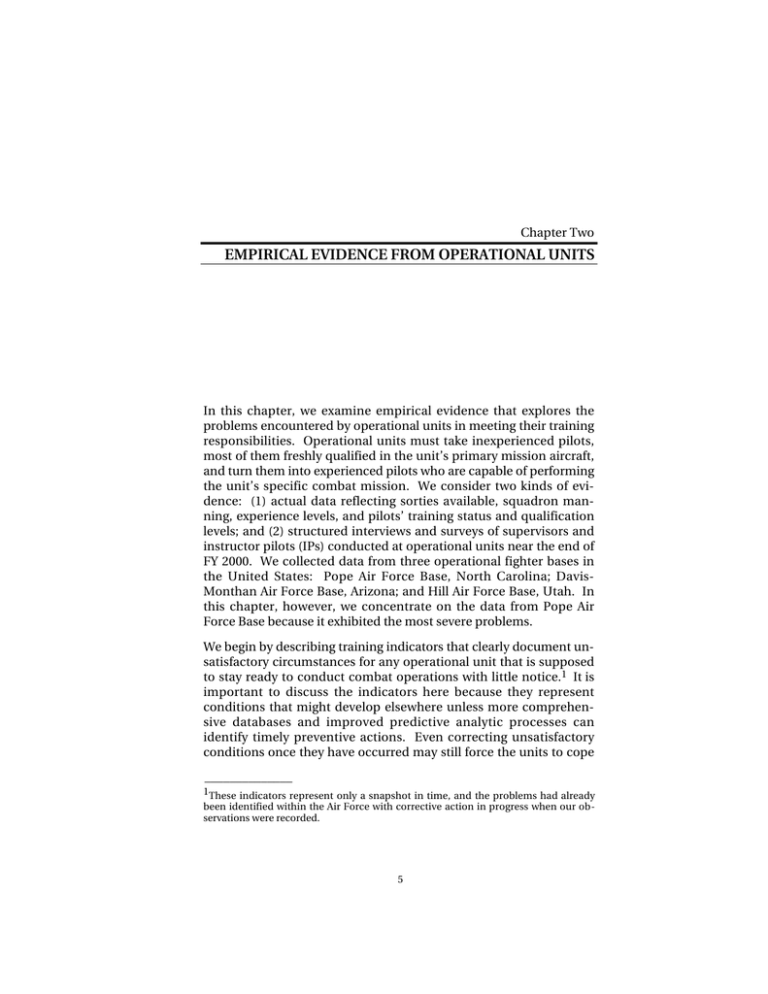
Chapter Two EMPIRICAL EVIDENCE FROM OPERATIONAL UNITS In this chapter, we examine empirical evidence that explores the problems encountered by operational units in meeting their training responsibilities. Operational units must take inexperienced pilots, most of them freshly qualified in the unit’s primary mission aircraft, and turn them into experienced pilots who are capable of performing the unit’s specific combat mission. We consider two kinds of evidence: (1) actual data reflecting sorties available, squadron manning, experience levels, and pilots’ training status and qualification levels; and (2) structured interviews and surveys of supervisors and instructor pilots (IPs) conducted at operational units near the end of FY 2000. We collected data from three operational fighter bases in the United States: Pope Air Force Base, North Carolina; DavisMonthan Air Force Base, Arizona; and Hill Air Force Base, Utah. In this chapter, however, we concentrate on the data from Pope Air Force Base because it exhibited the most severe problems. We begin by describing training indicators that clearly document unsatisfactory circumstances for any operational unit that is supposed to stay ready to conduct combat operations with little notice.1 It is important to discuss the indicators here because they represent conditions that might develop elsewhere unless more comprehensive databases and improved predictive analytic processes can identify timely preventive actions. Even correcting unsatisfactory conditions once they have occurred may still force the units to cope ______________ 1These indicators represent only a snapshot in time, and the problems had already been identified within the Air Force with corrective action in progress when our observations were recorded. 5 6 Absorbing Air Force Fighter Pilots with highly undesirable circumstances. It would be far better to prevent their occurrence in the first place. POPE AIR FORCE BASE TRAINING INDICATORS 2 Combat Mission-Ready Status In the month before our visit, fewer than 50 percent of assigned A/OA-10 pilots were actually mission qualified in the sense that they were currently certified as combat mission ready (CMR) or even in basic mission-capable (BMC) status.3 Worse, only 31 (about 37 percent) of the assigned primary mission pilots (designated aircrew position indicator-1, or API-1) were carried in CMR status. Typically, we would expect virtually all API-1 pilots who had completed initial mission qualification training (MQT) to be certified as CMR, and we would further expect the staff and supervisory pilots who had finished MQT (designated API-6) to be divided between CMR and BMC status on the basis of their specific duties. However, only six of the assigned API-1 pilots were still in MQT, leaving 47 who had lost their CMR status because they had been decertified as a result of training deficiencies. There are several potential reasons for such decertifications, but our information indicated that most occurred because the pilots had flown an insufficient number of sorties to meet CMR standards. ______________ 2Our host was the 23rd Fighter Group (FG), a tenant unit at Pope Air Force Base, an Air Mobility Command (AMC) base. The group is responsible for two fighter squadrons (FSs), the 74th FS and the 75th FS. Its parent fighter wing (FW) had just changed from Moody Air Force Base, Georgia, to the 4th FW, Seymour Johnson Air Force Base, North Carolina, the month before. Squadron commanders are responsible for certifying the mission status and other qualification information for their assigned and attached pilots monthly on documents called Letters of Xs. The information cited here is from the Letters of Xs provided in July 2000, before our August visit. 3In AFI 11-2A/OA-10, CMR is defined in paragraph 1.4.4.1 as “the minimum training required for pilots to be qualified and proficient in all of the primary missions tasked to their assigned unit and weapon system.” (See Department of the Air Force, AFI 112A/OA-10, Vol. 1, A/OA-10 Aircrew Training, February 11, 2000.) BMC is defined in paragraph 1.4.4.3 as “the minimum training required for pilots to be familiarized in all, and may be qualified and proficient in some of the primary missions tasked to their assigned unit and weapon system.” Emperical Evidence from Operational Units 7 Documented Training Problems The fact that the limited number of available sorties presented a problem was corroborated by the quarterly performance measure (QPM) data that the unit had compiled for reporting purposes. This information confirmed that API-1 A/OA-10 pilots assigned at Pope Air Force Base had averaged under six sorties per month during the first six months of 2000. This is less than two-thirds of the current Air Combat Command (ACC) objective value of 9.8 sorties per month. Bomb scores recorded during training sorties provided documentation for another training problem for the pilots at Pope. Squadron circular error averages (CEAs) for bombs dropped in two primary events in 2000 were more than 50 percent greater than they had been for the same events in 1997, when pilots were averaging more sorties per month.4 The final documented problem was a marked increase in the difficulties pilots were experiencing during formal check rides. The number of unsatisfactory performances and other discrepancies prompted flight examiners to express specific concerns to us regarding check ride standards. Their dilemma was as follows: Should pilots who have been decertified from CMR status owing to lack of training still be held responsible for meeting mission standards on check rides? If not, what standards should be met? Flight examiners also expressed concern about poor performance by pilots on instrument checks. Although these checks evaluate more fundamental skills and adhere to more basic standards than do mission checks, should the pilot be held responsible for errors that result from lack of training and inadequate opportunity to practice essential instrument flying skills? Again, standards have never been set for “nonproficient” pilots. This concern has important implications for overall readiness and safety.5 ______________ 4A squadron CEA represents the mean of the distribution of bomb scores for all the record deliveries made by pilots in that squadron. The bombing events were highaltitude dive bomb (HADB) and low-angle high-drag (LAHD) pop deliveries. The actual CEA increases were nearly 12 meters in HADB and nearly 8 meters in LAHD pop, respectively. Data are from the 23rd FG. 5Pilots receive periodic check rides in two areas: Mission checks measure their ability to fly their combat mission, and instrument checks measure their ability to operate, navigate, and recover their aircraft in adverse weather conditions. Since check ride re- 8 Absorbing Air Force Fighter Pilots Survey Results During our site visit, we conducted interviews and administered written surveys to supervisors and IPs assigned to our host group. The comments and responses we received also confirmed training problems. For example, 100 percent of the respondents identified an ongoing problem with the quantity of training inexperienced pilots were receiving. This is a direct consequence of the lack of available sorties for them to fly. In addition, 100 percent of the respondents identified the quality of training as a continuing problem. Respondents identified several causes of degraded training, some of which dealt with facility issues such as the location and adequacy of training ranges and the availability of training airspace allocations. Most respondents, however, indicated that the principal cause of diminished training quality was that too many sorties were flown by flight members whose currency or proficiency had been degraded by a lack of recent training opportunity, resulting in less realistic and less effective training missions. The second most common cause of reduced training quality was that too many sorties had to be clustered so that pilots could regain or maintain training currencies, avoid mission status probation or decertification, or regain mission status qualification. This meant that many of the sorties inexperienced pilots received were limited to constrained profiles that prevented them from understanding more advanced mission characteristics. The final survey result addressed the sensitive issue of safety implications. IPs and supervisors were asked whether wingmen in their units were “flying advanced missions without a fundamental foundation in certain basic skills.” Almost 90 percent of respondents indicated that this was occurring at least half the time. _____________________________________________________________ sults become part of a pilot’s permanent record and are used to determine operational viability in competing for key positions and future assignments, poor evaluations early on could have serious career consequences. Emperical Evidence from Operational Units 9 Manning and Experience Problems A primary reason individual pilots were flying so few sorties at the time of our visit was that almost 20 percent more pilots had been assigned to the group than had been authorized. This meant that the sortie resources that were available for training had to be distributed over a greater number of pilots than the system had intended, so each pilot flew fewer sorties on average than would have been the case at a 100 percent manning level. Again, it is useful to look at the manning problem from a primary mission pilot perspective. The group had 84 API-1 pilots assigned against 72 authorizations, so the API-1 billets were overmanned by 12 pilots, or 16.7 percent. If the group had been able to distribute the total number of API-1 sorties per month it was averaging at the time among 72 pilots instead of 84, each pilot could have flown roughly one additional sortie on average per month. This is also a 16.7 percent increase in the monthly sortie average and, using the historical A-10 average sortie duration (ASD) to estimate the corresponding flying hours, represents 1.85 additional hours each pilot could have flown (again on average) per month. This is a significant difference. Another problem that had an adverse effect on training at Pope Air Force Base was a shortage of experienced pilots. We will address specific definitions and examine them in a historical context in Chapter Four, but for the moment we will simply note that only 31 of the 84 line pilots assigned met existing Air Force criteria to be identified as experienced pilots. This meant that fewer than 37 percent of the assigned API-1 pilots were experienced. This is important because in our previous work, we observed that low experience levels meant that new pilots flew fewer sorties on average per month than the overall average. Thus, the new, inexperienced pilots flew even fewer than the six sorties per month that constituted the group average. 6 Indeed, group records indicate that inexperienced pilots ______________ 6 This issue will recur throughout this report. Inexperienced pilots can rarely fly training sorties without being supervised by experienced pilots, who function either as flight leads (in single-pilot aircraft) or as aircraft commanders (in multipilot circumstances). Our research confirmed that fighter units can spread sorties uniformly among pilots of all types when experience levels exceed 60 percent but that lower experience levels require that experienced pilots fly more sorties on average than inexperienced ones. This difference continues to increase as experience levels drop. See 10 Absorbing Air Force Fighter Pilots averaged fewer than five sorties per month during the first six months of 2000. When new pilots receive training at a rate this low, it is difficult for them even to maintain their perishable flying skills, let alone continue to develop the new skills required to acquire a fundamental understanding of the operational mission. There is also an ongoing concern that not enough experienced pilots may be available to supervise the training that the new pilots require for their development. The experience problem was further complicated by the method used to report unit experience levels. The formula specified for use in the AFI governing aircrew management assumes 100 percent manning and can thus yield misleading results for units that are overmanned. Indeed, the reported experience level at Pope Air Force Base at that time was 48.6 percent, which is considerably higher than the actual experienced/assigned ratio of 31/84, or 36.9 percent.7 In the presence of overmanning, experience problems can be masked by the reporting system that provides essential information to Air Force decisionmakers. A Summary of Adverse Training Indicators In sum, we found the following indicators of adverse training conditions: • Forty-seven primary mission pilots were decertified from CMR status, compared with only 31 API-1 pilots who were able to maintain CMR status. • Training documentation confirmed that pilots had low monthly sortie averages, exhibited performance degradation in squadron _____________________________________________________________ William W. Taylor et al, The Air Force Pilot Shortage: A Crisis for Operational Units? MR-1204-AF, Santa Monica: RAND, 2000. 7See Department of the Air Force, AFI 11-412, paragraph 4.5.1.2.4, August 1, 1997, for the “official” formula. It starts with the total number of experienced pilots assigned (including API-6 as well as API-1 pilots) and subtracts the API-6 authorizations to estimate the number of experienced API-1 pilots assigned. This estimate is 31 + 24 – 20 = 35 for the circumstances at Pope Air Force Base in July 2000. The formula then divides this estimate by the total number of API-1 pilots authorized, not assigned, to yield 35/72 = 48.6 percent for the Pope numbers. We will discuss both the definition and the formula in more detail in Chapter Four. Emperical Evidence from Operational Units 11 CEAs for primary bombing events, and generated concerns over poor check ride performance. • Survey data indicated that 100 percent of IPs and supervisors were concerned that inexperienced pilots had problems with both the quantity and the quality of available training. A sizable portion also expressed concern that wingmen in their units were flying advanced missions without a fundamental foundation in certain basic skills. • Manning and experience levels exacerbated the problems. Available training resources had to be distributed among an API-1 pilot population that was 16.7 percent overmanned and only 36.9 percent experienced even though the reported experience level was 48.6 percent. These conditions clearly describe an unacceptable training environment with both safety and readiness problems. As mentioned previously, our intent is to identify the causal factors to see how these circumstances can be avoided. The primary cause, of course, is that too few sorties were available to inexperienced pilots. PRODUCTION DECISIONS AND UNINTENDED CONSEQUENCES In a seeming contradiction, the A-10 units were overmanned at the same time that the Air Force was enduring (and continues to endure) an overall shortage of pilots. This finding led us to examine the underlying factors that could create this unique condition. Our investigation revealed that in 1996, the Air Force had decided to increase its fighter pilot production quotas to 370 pilots per year. The F-16, however, which accounts for almost half of the active fighter force, already had its training facilities operating at maximum capacity. This meant that it would take time to increase F-16 pilot production capacity. In the meantime, the production of other types of fighter pilots was increased wherever the capacity was available to do so. Although the fighter pilot production objective was reduced to 330 pilots per year in 1999, the lead time in the training pipeline caused fighter pilot production levels to average nearly 340 pilots per year for the three-year period from FY 1997 through FY 1999. Many 12 Absorbing Air Force Fighter Pilots of the additional pilots who were produced during this period were in the A-10, and its pilot production numbers exceeded steady-state requirements by an average of almost 30 percent per year.8 Air Force agencies were already implementing policies to correct the problems that had been caused when the units were required to take in more new pilots than they could possibly absorb. More abiding questions were raised, however, regarding what it would mean for units to absorb new pilots and whether, given the response time of the system, the aircrew management system could recognize and react to conditions soon enough to forestall problems. OVERMANNING AND INFEASIBLE OBJECTIVES Our investigation and the analytic tools we subsequently developed indicate that the fighter group at Pope Air Force Base was tasked to take in more pilots than it could have trained with its available primary aircraft authorization (PAA). It could have increased its sortie production to historical highs and still have failed to meet the training objectives that were specified. Our analyses confirm that the eventual consequences when a unit is tasked to take in more new pilots than it can train will always be similar to the conditions we observed at Pope. If the unit had been able to produce additional sorties per authorized airframe, the primary difference would not have been the final outcome but only the amount of time required for the consequences to become so dire. This reflects the dynamic nature of the process when it is forced to operate in an unstable regime. We will develop this concept in subsequent sections. The effects of overmanning are extremely difficult for a unit to control. Our models show that each additional new pilot who is added ______________ 8The production goal of 370 fighter pilots was set in 1996 at a Four-Star Rated Summit that also set the production goal for all pilots at 1100 per year. The April 1999 summit kept the total pilot production objective of 1100 but reduced the fighter pilot goal to 330 pilots because it was recognized that unit experience objectives could not otherwise be met. The June 2001 summit reconfirmed both of these numbers and added the proviso that all 330 fighter pilots would be absorbed in active units (30 of them had been programmed for guard or reserve units in 1999). Actual A-10 pilot production numbers for FY 1997, FY 1998, and FY 1999 were 63, 72, and 80, respectively, compared to a steady-state requirement of 56. (Data in this footnote are from AF/XOOT and the Air Force Personnel Center [AFPC].) Emperical Evidence from Operational Units 13 to an A-10 squadron subtracts roughly 0.7 sortie per month from the rate at which inexperienced pilots are gaining experience. We expect that the only way the group at Pope could have met its training objectives in a steady-state environment would have been to ensure that the parameters defining its new pilot absorption objectives were sufficiently compatible to be simultaneously achievable. This would have required that it take in fewer pilots or increase its aircraft authorizations (i.e., its force structure). The Effect of Absorbing Fewer Pilots or Increasing PAA Increasing PAA helped save the 354th FS at Davis-Monthan Air Force Base. The manning and experience conditions of this squadron were also quite poor in late 1999 and early 2000. In the summer of 2000, however, the squadron received six additional aircraft as part of a force structure shift. The early arrival of these aircraft effectively boosted the 354th FS from 18 to 24 PAA without an immediate corresponding increase in its manning authorizations. Other propitious circumstances also helped the squadron overcome its problems. Because the Marine Corps volunteered to take its place for an upcoming Kuwait rotation, the squadron was able to remain at its home station while retaining its original deployment priority for spare parts and maintenance. It also received support from experienced IPs assigned to the A-10 training squadrons in their wing. When the increased pilot authorizations eventually became effective, the A-10 pilot overproduction problems had been resolved so that the new authorizations could be filled from existing pilot overages. This combination of extra airframes, priority for parts, and the opportunity to keep its experienced pilots on base to continue homestation training helped the squadron recertify most of its non-CMR pilots and markedly reduce its probationary counts by the time of our visit in the fall of 2000. The PAA increase, however, was most instrumental in resolving the difficulties. It took much longer to resolve the problems at Pope Air Force Base, where things did not improve until well after the flow of new incoming pilots had slowed to a manageable level. This had already begun when we visited because the sustained pool of at least ten API-1 pilots undergoing initial MQT that prevailed from November 1999 until May 2000 had dropped to six by July 2000. By July 2001, the number 14 Absorbing Air Force Fighter Pilots of pilots undergoing MQT had dropped to zero. The reduced flow of new pilots allowed total pilot manning to reach manageable levels by February 2001, although the proportion of experienced API-1 pilots did not actually begin to increase until July 2001. The number of API-1 pilots who were qualified as four-ship flight leads and IPS, however, increased steadily during 2001. Also by July 2001, only 11 API-1 pilots remained decertified from CMR status. These indicators confirm that circumstances have definitely improved, but these improvements occurred slowly and were achieved only because the flow of new pilots into the squadrons finally dropped to manageable levels. In addition, an ACC site activation task force (SATAF) is addressing the unique problems Pope Air Force Base identified, such as low priority for certain maintenance facilities as a tenant unit and long distances from suitable range and airspace locations. The original recommendations that were driven by funding limitations may receive further review. Also, an ACC Tiger Team has examined potential means of increasing A-10 aircraft mission-capable rates. AFTERWORD Our purpose in documenting the circumstances at Pope Air Force Base is to illustrate circumstances that the Air Force should strive to avoid in the future. We would like to help ensure that units never have to operate in similar conditions again. To be sure, our intent is not to embarrass anyone. Indeed, the people at Pope Air Force Base who worked under these difficult circumstances deserve credit for continuing to work toward improving training opportunities as well as for maintaining remarkable morale levels in view of the existing circumstances. The longitudinal database that we used to document the indicators at Pope and Davis-Monthan Air Force Bases may serve as a prototype for the sort of information aircrew managers may need to use in the future. The survey results are part of an ongoing effort to identify and measure actual training shortfalls in terms of individual skills and unit capabilities and to communicate the results in terms that are fully apparent to policy decisionmakers. They will be documented when that portion of the study is complete.
